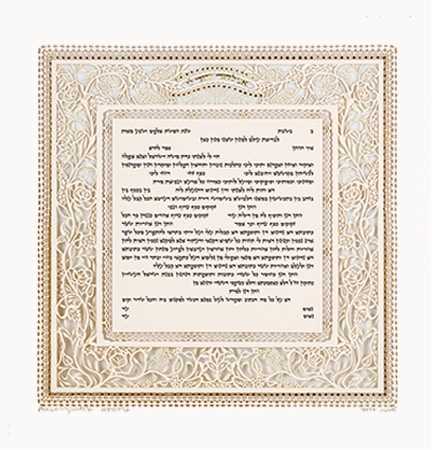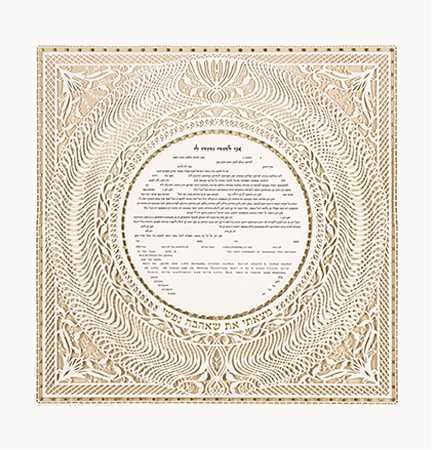

Ketubah Categories
Ketubah art is an art like no other. It is exciting to create; it is exciting to purchase and the very best of ketubah artwork will continue to engage its viewers for years on end. Danny Azoulay ketubahs do all of the above.
Just talk to Danny about his inspiration, work process– or even about making a ketubah sale and you can see and hear the enthusiasm and the deep satisfaction he gets from making beautiful ketubahs. “Azoulay Art began years ago, after I finished studying at Bezalel (Art Academy). I made hand painted ceramic Judaica for years; I love working in 3-dimensional design. The challenges of bringing shape, function, color and ornamentation considerations together to create meaningful Jewish ritual art is tremendously rewarding for an artist. But, when I began to discover the artistic possibilities of making ketubot and the challenges involved in creating modern ketubah art—one that can combine traditional ketubah themes and symbols with new techniques and the visual alphabet of modern designs, I was hooked and happy.”
Happiness has a lot to do with ketubah art in general, and in Danny Azoulay art, in particular. A traditional ketubah is a Jewish marriage contract, but the fact that, in Jewish communities, marriage is considered the very most auspicious of life cycle events, the beautification of this legal document has become paramount to its very essence.
The ketubah artwork selected by the bride and the groom is surely an expression of who the couple are. In some intangible and visual way, the design has the ability to touch, not only, the couple’s aesthetic sensibilities, but their values, their cultural histories, childhood memories as well as their dreams and aspirations. And, of course, ketubot are a lasting reminder commemorating the joy of their wedding day.
Danny offers a wide range of artistic styles in his Jewish wedding ketubahs, placing an emphasis on fusion. He weaves diverse motifs of decorative, traditional Jewish and symbolic significance together with a cerebral and incandescent intelligence. The result has the effect of evoking a nostalgia for the past, originality and renewal and a vigorous nod to the future. Danny’s artistic process is one of constant discovery: searching the past for inspiration, incessant observation and the pursuit of relevance.
The art of the papercuts has a robust history in Jewish art. With almost no exceptions, Jewish art before the 19th century predominantly consisted of ritual objects, illuminated manuscripts and synagogue decorations, very often the product of non-Jewish artists and artisans. The papercut was an art that could be practiced in the home with little more than paper and a knife and no formal training. So, it is not surprising that beautifully adorned papercut ketubot have been discovered from widespread Jewish communities and regions.
Historically, the ketubah dates as far back as two thousand years ago. Though in the recent past, it underwent a period of being disparaged and misunderstood--as a contract that bound women to their husbands--the ketubah, in its very conception, was devised as a safeguard for a wife. It delineated exactly what her husband's obligations were to herself and secured her with a contract, signed in the presence of witnesses, that ensured financial security should she divorce or be widowed. After the ceremony, the ketubah was placed in the hands of the bride or the bride’s family for safekeeping.
Today, in our far more egalitarian climate where women are no longer financially dependent on their spouses, the modern ketubah has undergone a transformation. Although the traditional ketubah in Orthodox Jewish communities is still very much the same in word and content as was, the modern ketubah has become more relevant as a written proclamation of the bride and groom’s mutual marriage vows. These vows are personal, affirming the commitment to cherish and love one and another. Many couples elaborate further, asserting their hopes and intentions to build a home together based on their faith, values and beliefs. Some couples choose to further expand upon their vows, including a road map for the kind of life they envision creating together.
Shopping with your partner for your ketubah can be a truly amazing experience. Yes, seriously. Discussions that you will have on what the two of you consider beautiful or not and which text includes the things you both consider significant and essential can lead to some incredible self-exploration, exchange of views and quite a few surprises. It can be quite the journey! So, our advice is to enjoy the process.
The ketubah signing is one of the most potent moments of the Jewish wedding ceremony. It is a tradition that is a binding Jewish marriage contract and still it is so much more. It is a testimony of the joy of the wedding day, a public statement of commitment today and tomorrow, an artwork to be cherished and to adorn one’s home and an heirloom to be treasured by generations to follow.
Danny’s ketubahs widely vary in design and style: more traditional ketubahs, less traditional ketubahs, modern ketubahs and contemporary art ketubahs. This is true, too, for the wide range of texts in Aramaic, Hebrew and English that he offers. Need a custom text? Let us know.
Danny Azoulay loves doing what he is doing and you can see that love present and manifest in all his ketubah artwork.
Just talk to Danny about his inspiration, work process– or even about making a ketubah sale and you can see and hear the enthusiasm and the deep satisfaction he gets from making beautiful ketubahs. “Azoulay Art began years ago, after I finished studying at Bezalel (Art Academy). I made hand painted ceramic Judaica for years; I love working in 3-dimensional design. The challenges of bringing shape, function, color and ornamentation considerations together to create meaningful Jewish ritual art is tremendously rewarding for an artist. But, when I began to discover the artistic possibilities of making ketubot and the challenges involved in creating modern ketubah art—one that can combine traditional ketubah themes and symbols with new techniques and the visual alphabet of modern designs, I was hooked and happy.”
Happiness has a lot to do with ketubah art in general, and in Danny Azoulay art, in particular. A traditional ketubah is a Jewish marriage contract, but the fact that, in Jewish communities, marriage is considered the very most auspicious of life cycle events, the beautification of this legal document has become paramount to its very essence.
The ketubah artwork selected by the bride and the groom is surely an expression of who the couple are. In some intangible and visual way, the design has the ability to touch, not only, the couple’s aesthetic sensibilities, but their values, their cultural histories, childhood memories as well as their dreams and aspirations. And, of course, ketubot are a lasting reminder commemorating the joy of their wedding day.
Danny offers a wide range of artistic styles in his Jewish wedding ketubahs, placing an emphasis on fusion. He weaves diverse motifs of decorative, traditional Jewish and symbolic significance together with a cerebral and incandescent intelligence. The result has the effect of evoking a nostalgia for the past, originality and renewal and a vigorous nod to the future. Danny’s artistic process is one of constant discovery: searching the past for inspiration, incessant observation and the pursuit of relevance.
The art of the papercuts has a robust history in Jewish art. With almost no exceptions, Jewish art before the 19th century predominantly consisted of ritual objects, illuminated manuscripts and synagogue decorations, very often the product of non-Jewish artists and artisans. The papercut was an art that could be practiced in the home with little more than paper and a knife and no formal training. So, it is not surprising that beautifully adorned papercut ketubot have been discovered from widespread Jewish communities and regions.
Historically, the ketubah dates as far back as two thousand years ago. Though in the recent past, it underwent a period of being disparaged and misunderstood--as a contract that bound women to their husbands--the ketubah, in its very conception, was devised as a safeguard for a wife. It delineated exactly what her husband's obligations were to herself and secured her with a contract, signed in the presence of witnesses, that ensured financial security should she divorce or be widowed. After the ceremony, the ketubah was placed in the hands of the bride or the bride’s family for safekeeping.
Today, in our far more egalitarian climate where women are no longer financially dependent on their spouses, the modern ketubah has undergone a transformation. Although the traditional ketubah in Orthodox Jewish communities is still very much the same in word and content as was, the modern ketubah has become more relevant as a written proclamation of the bride and groom’s mutual marriage vows. These vows are personal, affirming the commitment to cherish and love one and another. Many couples elaborate further, asserting their hopes and intentions to build a home together based on their faith, values and beliefs. Some couples choose to further expand upon their vows, including a road map for the kind of life they envision creating together.
Shopping with your partner for your ketubah can be a truly amazing experience. Yes, seriously. Discussions that you will have on what the two of you consider beautiful or not and which text includes the things you both consider significant and essential can lead to some incredible self-exploration, exchange of views and quite a few surprises. It can be quite the journey! So, our advice is to enjoy the process.
The ketubah signing is one of the most potent moments of the Jewish wedding ceremony. It is a tradition that is a binding Jewish marriage contract and still it is so much more. It is a testimony of the joy of the wedding day, a public statement of commitment today and tomorrow, an artwork to be cherished and to adorn one’s home and an heirloom to be treasured by generations to follow.
Danny’s ketubahs widely vary in design and style: more traditional ketubahs, less traditional ketubahs, modern ketubahs and contemporary art ketubahs. This is true, too, for the wide range of texts in Aramaic, Hebrew and English that he offers. Need a custom text? Let us know.
Danny Azoulay loves doing what he is doing and you can see that love present and manifest in all his ketubah artwork.
Our Couples Say...

Our Simple Ordering Process
Every year, couples from all over the world, choose to celebrate their wedding with one of Danny’s ketubahs.
We have a wide selection of texts: Conservative, Orthodox, Reform, Interfaith and a choice of Modern texts.
If you’ve decided on personalization (filling in your names, wedding date and location), simply select the personalization option before checkout and we will send you a personalization form.
After returning the personalization form, we will send you a proof of your text as it will appear on your ketubah. As soon as you give us your confirmation, we will begin the final ketubah process.
Upon shipping your ketubah, we will send you a tracking number.
The Artwork
Danny’s paper cut ketubahs are the fruit of inspired study, creativity and a heightened sense of design. A synthesis of the timeless beauty of tradition and the excitement of innovation are the primary considerations in Danny’s creative process.







